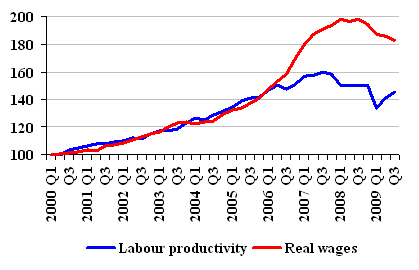The gap between wages and productivity is narrowing rapidly
One of the main causes for the unbalanced economy, the gap accumulated in previous years between wages and productivity, is currently shrinking rapidly, thus restoring competitiveness of the economy and creating a basis for a revival of economic activity.
In the third quarter of 2009, for the second consecutive quarter, hourly productivity has increased (over the year, by 11.4%). That is considered a pre-emptive indicator vis-à-vis the GDP dynamic, for changes in productivity usually occur before changes in GDP.
In the third quarter, costs per unit labour continued to diminish, i.e. the indicator of the labour costs for producing one GDP “unit”. That was determined by both the increase in the hourly productivity of labour (on average, more is being produced in an hour of labour) and reduction in the costs for one hour of labour (3.9% over the year, with wages contracting by 6.4%) Assuming that in the first quarter of 2000, the wages in the country were commensurate with productivity and representing the cumulative seasonally adjusted wage and productivity levels from this time, it becomes obvious that the gap between wages and productivity appears in the third quarter of 2006, expanding until the first quarter of 2009. The real hourly wage grew faster than productivity up until the end of 2007, and after that the difference between these indicators increased mainly as a result of dropping productivity.
Within six months, i.e. in the second and third quarters of 2009, one third of the difference between wages and productivity has been eliminated. Moreover, if we assume that, as in all likelihood was the case, the actual wage level prior to the leap in the second half of 2006 was lower than the level commensurate with productivity – among other factors, the income of employees in total value added, at the time among the lowest in the EU, points to that – by the end of the third quarter of 2009, the greatest part of the gap accumulated between wages and productivity was cancelled.
The third quarter GDP and labour cost data indicate that, first, the gap between wages and productivity is closing fast and, second, rising productivity plays the decisive role in this process. This is a positive development, for thus balancing the wages with productivity is achieved through a lesser reduction in wages.

Cumulative levels of real wages and productivity. (2000/I = 100).
Seasonally adjusted data. Source: Central Statistics Department data; Bank of Latvia estimate.
Textual error
«… …»






